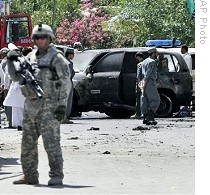Washington
09 September 2009
 |
| US soldier stands guard near site of suicide attack in Mehterlam, 02 Sep 2009 |
A conflict the U.S. fought and lost some 40 years ago has come back to haunt a young president, his advisors, his generals, and the country he governs. What some call the V-word - Vietnam - is increasingly heard in the growing debate over U.S. involvement in Afghanistan. Voices, even within President Barack Obama's own party, warn that the United States risks being drawn into a Vietnam-like quagmire and that Afghanistan may become Obama's Vietnam.
Similarities
Anthony Cordesman, senior analyst at the Center for Strategic and International studies, says the comparisons were brought home to him during a recent trip to Afghanistan.
"What I found being in Afghanistan was problems all too familiar of not only in Iraq, but in Vietnam years ago," he said. "We are fighting a war a half a century later that we lost for similar reasons a half a century earlier.
Back then, a request to send more troops to the combat theater was called an escalation. Today it is a surge. But now, like then, American troops hunt the rough terrain for an elusive enemy who hides among the populace or takes sanctuary across the border in a neighboring country. Civilian casualties fuel further resentment. And corruption pervades the government in Kabul as it did in what was once Saigon, the capital of South Vietnam.
Retired Army Lieutenant Colonel Larry Wilkerson was chief of staff to Secretary of State Colin Powell during the Bush Administration. He is also a Vietnam veteran. He says the video clips sent to him by military friends in Afghanistan raise unsettling comparisons to his own experiences in Vietnam years ago.
"You're looking at them and saying, this is my firebase in the Palm of Reeds in Vietnam," he said. "This is the same thing as in the Angel's Wing next to Cambodia - sanctuary for the enemy, can't go across that line, can't get into that area where the enemy is. This is a corrupt government in Kabul. This is various and sundry ways that we're trying to win the peoples' hearts that aren't working. This is trying to bring security to a hamlet - we pull out, the hamlet no longer has security, and the Taliban take over. There are so many similarities it's frightening."
The starkest similarity, in many analysts' eyes, is the issue of sanctuary. Just as the Viet Cong and regular North Vietnamese troops used Laos and Cambodia as sanctuaries, the Taliban has used the tribal areas of neighboring Pakistan as a refuge. President Richard Nixon invaded Cambodia in 1970 to strike the sanctuaries. The U.S. has been using unmanned drone aircraft against Taliban sanctuaries in Pakistan.
But as analysts Charles Kupchan of the Council on Foreign Relations points out, security and political considerations rule out such an option in Pakistan.
"Even though the United States is conducting attacks on Pakistan territory through drones, the United States does not have permission, if you will, to send its own forces into Pakistan territory," he said. "And so in that sense the Taliban, to some extent, has safe harbor, can come across the border into Afghanistan, do damage, and then sneak back into Pakistan.
Differences
There are major differences between the two conflicts, however. Afghanistan is much more ethnically diverse, with deep tribal links. The stated goal of the Afghan conflict is to deny the Taliban and its al-Qaida allies a home base from which to attack targets in the West. The goal in Vietnam was to stop a Communist-backed insurgency.
American troop strength in the then-South Vietnam went from 184,000 at the end of 1965 and increased to 537,000 by the end of 1968. The U.S. is expected to have 68,000 troops in Afghanistan by the end of this year, but that may increase if General Stanley McChrystal asks for additional troops, and President Obama approves it.
The United States had conscription during the Vietnam war era, which fueled massive antiwar protests, but today has an all-volunteer armed force. This, say analysts, has dampened any large and widespread antiwar demonstrations. Erik Leaver of the Institute of Policy Studies says one big difference is that the strongest opposition about Afghanistan may form over the financial cost of the war rather than the human one.
"We had a much different dynamic of what was going on inside of Vietnam insofar as what was the cost, the human cost of the war," said Leaver. "The financial cost is a totally separate matter, and I think that as we're starting to feel the economic pinches here at home as the president has to go and ask for more money for Afghanistan, we'll probably see some similar sorts of pushbacks to what we had in Vietnam."
More than 58,000 American soldiers were killed in Vietnam. Less than 1,000 American troops have died in Afghanistan - so far.